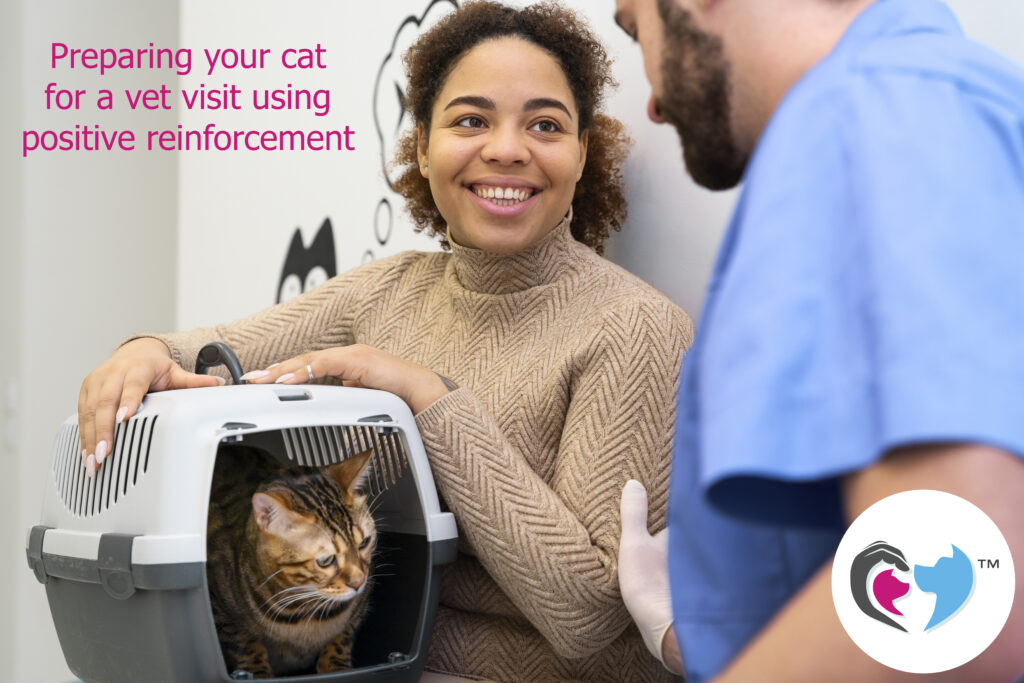Visiting the veterinarian is essential to maintaining your cat’s health and well-being. However, many cats find vet visits stressful and overwhelming. Fortunately, with the proper preparation, patience, time and positive reinforcement techniques, you can help your feline friend feel more comfortable and relaxed during these visits. In this article, we will explore practical strategies to prepare your cat for a vet visit, creating a positive experience for you and your beloved companion.
1. Familiarise Your Cat with the Carrier: A carrier is necessary to safely transport your cat to the vet. Help your cat associate the carrier with positive experiences by providing daily meals in the carrier. Leave the carrier in a communal area, place comfortable bedding inside, flick treats in there for your cat to find (in her own time, so it’s a happy surprise), or sprinkle catnip inside it every other day. If it’s available to your cat 24/7, it’s not a predictor of scary things, and if you cat sleeps in it by choice, it becomes a safe haven.
2. If your cat is already anxious at the sight of carriers or is associating it with the sounds and smells of a vet visits, spend some time changing his emotional response to the crate. Start by habituating the cat to the presence of the carrier – this is done by putting the carrier in plain sight (but not near litter boxes, exits/entrances, food, water or a favourite sleeping spot) and leave it there for as long as it takes for the cat to stop being worried about its presence. Once it’s become ‘part of the furniture’ you can start pairing its existence with positive experiences. For example, offer treats or engage your cat in play in the same room that the carrier is standing in. Don’t start too close to the carrier though – at no point should this be a forced interaction. When your cat is happily playing in the same room as the carrier, you can progress to placing treats inside the carrier and leave your cat to enter voluntarily. Stressed animals don’t play, so use his enthusiasm for play near the crate as an indicator that he’s ready to move on to the next step. Don’t force him, and don’t try to lure him inside. Treats must still happen outside the carrier too – if he’s forced to approach a scary thing to get a treat, it can induce conflict and stress. Only once he’s no longer worried about it and showing no signs of stress can you start flicking treats in the crate for him to go eat. Increase the duration of time spent inside the carrier, rewarding your cat for staying calm. Never lock him in during the initial process – and if he wants out, let him! Having some control and a choice in whether he stays in or goes out can help to reduce anxiety significantly. When he no longer feels scared by being in the crate, he won’t worry about being closed in for shorter periods, so acknowledge his need to escape during the initial reintroduction. Over time, this positive association will help reduce his anxiety.
3. Handling and Grooming Practice: Regularly handle and groom your cat at home, as this can help them become more accustomed to being touched and examined. This in turn will help to make veterinary examinations less stressful. When your cat is happy to engage with you, practice gentle handling techniques such as touching their paws, ears, and mouth. Reward your cat with treats or praise for allowing these interactions. Gradually introduce them to grooming tools like brushes or nail clippers, rewarding them for participating. If your cat pulls away or tries to leave, let him. When an animal says “no”, its not “no forever”, just “not right now”. By allowing them to withdraw when they are feeling under pressure, you help them to feel better about what’s happening and this will affect how they respond to this situation in future. This practice will make veterinary procedures more manageable, such as physical examinations, vaccinations, or nail trims.
4. Positive Reinforcement Training: Train your cat to perform basic behaviours on cue using positive reinforcement techniques. Teaching cues such as “sit,” “stay,” or “touch” can help distract and engage your cat during vet visits. Use treats, clickers, or toys to reward desired behaviours, making the training sessions enjoyable and reinforcing a positive association with the vet environment.
5. Mock Vet Visits: Simulate vet visits at home to familiarise your cat with the routine and reduce anxiety. Set up a table with a non-slip surface, similar to a veterinary clinic, and practice getting your cat in and out of the carrier. Introduce gentle handling examination procedures and reward your cat frequently to help him understand that this is not life-threatening. Gradually increase the criteria that he will have to cope with, incorporating carrier time and short car rides if possible.
6. Other options: If your cat is not making any progress, contact one of our COAPE Qualified Behaviourists for help. They will help you and your cat to work through this and may also suggest speaking to your veterinarian about products that can help alleviate your cat’s stress.
By preparing your cat for vet visits, you can help alleviate the stress and anxiety associated with these trips. Creating positive associations with the carrier, desensitising them to veterinary triggers, practising handling and grooming, and incorporating positive reinforcement training will empower your cat to feel more relaxed and cooperative during veterinary examinations. Remember, patience and consistency are critical, and respecting your cat’s boundaries and comfort levels is essential throughout the process. A well-prepared and positively reinforced cat will make vet visits smoother and contribute to their overall well-being and strengthening your bond with your feline companion.





